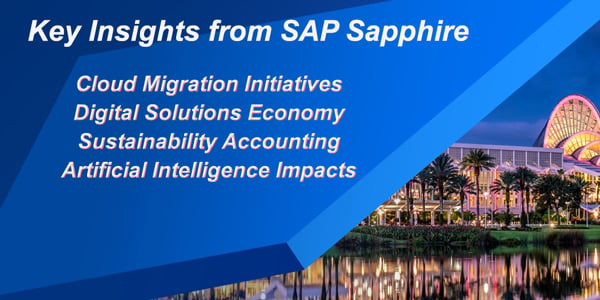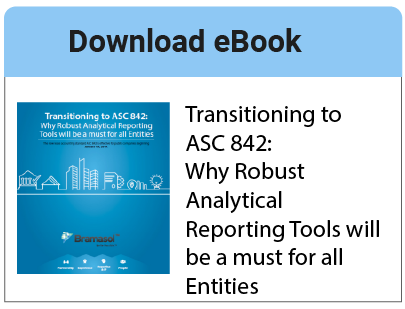The Bramasol team at SAP Sapphire all agreed that it was one of the best events we've attended in quite a while, with lots of opportunities for deep engagement with SAP experts. We also met with many forward-looking companies seeking to accelerate their digital transformation roadmaps, launch new Digital Solutions Economy™ offerings, and/or optimize their compliance programs.
The depth and quality of in-person discussions at Sapphire was informative, insightful and inspiring as new initiatives and ongoing trends gave shape to many specific SAP solutions as well as the overall future of the SAP ecosystem.
Below are four key trends that stood out as important areas to watch going forward.

1. Cloud Migration is Accelerating with New Initiatives
Highlighted during the keynote by SAP CEO, Christian Klein, the comprehensive SAP cloud portfolio rooted in the Business Technology Platform (SAP BTP), brings together "modular applications for each business function, like HR, procurement, finance, supply chain, and sales - to accelerate time to value"
The SAP Business Transformation Center is a new innovative cloud-based solution, powered by SAP Cloud Application Lifecycle Management (ALM), that enables organizations to effortlessly transform their data operations. Leveraging the SAP Business Technology Platform (BTP), the solution provides a guided approach to digital transformation that simplifies the transition to the intelligent enterprise.
As a comprehensive end-to-end solution, SAP Business Transformation Center optimizes every phase of the data transformation process, ensuring a seamless transition to a more agile and innovative enterprise.
In addition, the SAP Signavio Process Transformation Suite analyzes current business processes so that the customer can detect potential improvement areas and design new optimized end-to-end processes. SAP Business Transformation Center determines which data needs to be transferred. SAP Cloud ALM orchestrates the transition to track individual project tasks and monitor the process execution while in operations.
2. Digital Solutions Economy and XaaS are Disrupting More Industries
The second key arena that continues to drive waves of change across many industries is the disruptive trend toward subscription-based offerings in the Digital Solutions Economy (DSE). As more companies move to take advantage of the predictable recurring revenues and customer loyalty enhancements provided by DSE business models, it has become clear that a holistic approach is the only way to deliver front-end customer-facing flexibility combined with back-end scalability, profitability and compliance.
From our discussions at Sapphire with SAP executives in the quote-to-cash applications area, it's clear that the everything-as-a-service (XaaS) trend is gaining speed and breadth across virtually all industry sectors. This insight aligns with what Bramasol has been tracking for the past two years regarding the impacts of DSE in telecom, media, electronics, medical devices, software/SaaS, semiconductors, transportation, energy, and utilities.
In addition, this recent blog post looks at three different overall DSE use case scenarios and implementation approaches:
- Subscription business model pilot projects
- Moving from subscriptions to usage/consumption based models
- Greenfield implementation across advanced DSE offerings and enterprise ERP
The key to success is to understand how the SAP Quote-to-Cash portfolio of applications (formerly known as BRIM) can be selectively deployed to leverage the best value and business results. In some cases, a full-stack deployment makes sense however in other scenarios, companies may be best served by combining one or more specific applications such as Subscription Billing, Convergent Invoicing, Convergent Charging, Sales Order Management, Convergent Mediation, Sales & Distribution, etc., along with ERP, finance, and revenue recognition functions within the overall SAP ecosystem.
3. Sustainability Metrics Gain Focus with Green Line Accounting
Another major trend we've been tracking for the past few years is the increasing focus on sustainability and carbon accounting which also took center stage at Sapphire.
As part of the keynote, Christian Klein said, "Another key pillar for success of companies is management of the 'Green Line'. In addition to the top and bottom lines, consumers, employees, investors and auditors all want to support enterprises that care about the planet. However, today CFOs and chief sustainability officers need to deal with 20 times more climate regulations than in the past."
At Sapphire, SAP unveiled an update to its Sustainability Footprint Management tool that enhances the carbon emissions calculations and introduced a new component called the Sustainability Data Exchange within the SAP Business Network.
As part of SAP's green ledger initiative, the Sustainability Data Exchange application allows companies to request and exchange carbon data across supply chains, including sharing of actual Scope 3 product carbon footprints. The solution utilizes carbon data interoperability standards established by the Partnership for Carbon Transparency (PACT), which allows different emissions and accounting technology solutions to connect and share information.
After full release in Q3 2023, SAP will regularly update the emissions calculation engine and Sustainability Data Exchange in much the same way that it offers updates to tax calculations.
4. Artificial Intelligence (AI) Portends Major Impacts on Business Processes
Just as artificial intelligence has become a hot topic for discussions both within and beyond the tech world, Sapphire included significant news and insights into how AI is projected to impact business processes and how SAP is aligning their AI initiatives to support practical application of new technologies.
In a major new release, SAP and Google have announced that they will be expanding their partnership in the arena of open data and AI for enterprises that includes an open data offering designed to simplify data landscapes using a combination of both the SAP Datasphere solution and Google’s data cloud, that enables customers to build an end-to-end data cloud for seamlessly transporting data across the enterprise landscape.
Other joint announcements before and during Sapphire highlight joint AI initiatives which will take advantage of collaborative integration of solutions within the SAP ecosystem with data and applications from IBM and Microsoft.
As described by Christian Klein, "With generative AI, we will increase the productivity of every end user by changing how people work with our software. For example, our software will be able to answer any business-related question and recommend actions to improve your company's performance."
Summary
Overall, this was the most productive and informative Sapphire event in years. With attendance more than doubled from the previous year, opportunities for quality face-to-face interactions with SAP subject matter experts and with real-world users provided valuable insights for digital transformation success and dealing with crucial issues that companies are facing now and in the future.
For More Information, check out these resources:
- Video: BRIM Overview
- Forecasting and Planning for the Digital Solutions Economy
- DSE and RevRec Compliance,
- DSE Data Volume, Velocity, Density and Complexity
- Embedded Analytics for DSE
- Podcast: SAP's Carla LeJeune on Optimizing Entitlement Management
- Podcast: SAP’s Pete Graham on Anything-as-a-Service and How SAP Enables XaaS
- Webinar video: Managing Entitlements in the Digital Solutions Economy
- Webinar video: Power Transition to DSE with SAP Cash and Treasury Management

.png?width=3121&name=MicrosoftTeams-image%20(33).png)


